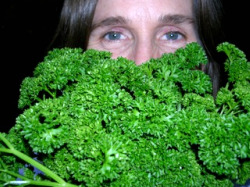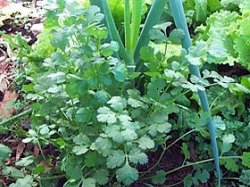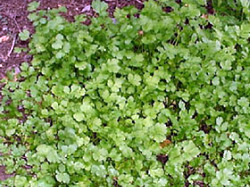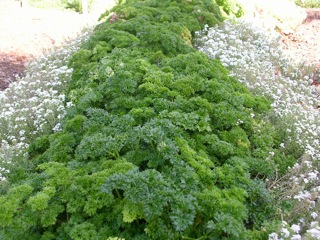
Parsley is a tasty and attract green to grow in your garden.
These two herbs are related, but offer different tastes. Both have become extremely popular for the unique flavors they add to ethnic dishes and their ease of growing. Native to the Mediterranean region, in ancient times parsley (Petroselinum crispum) was first used by the Greeks and Romans for everything but eating. It was used as an offering in burial rituals, to make wreathes to crown the victors of sporting events, and medicinally for a variety of ailments. It is known that parsley is high in vitamins A and C and minerals, is effective at removing toxins from the body, and can be used to treat rheumatoid arthritis. It's also a great natural breath freshener. The Romans first fed it to their horses, before realizing its medicinal and culinary properties. Parsley is delicious in salads or tabouli, on baked potatoes, and as a seasoning in many dishes.
Cilantro or coriander (Coriandum sativum) is also of Mediterranean origin, dating back almost 5000 years. Coriander is the spice made from grinding the seeds. Cilantro is the herb consisting of the leaves. Coriander seed has been found in Egyptian tombs. The ancient Greeks and Romans believed coriander seeds to have medicinal properties, including being an aphrodisiac. The popularity of this member of the parsley family has spread around the world, so that now it's commonly found in Chinese, Indian, and Latin American cuisines. It's used in dishes ranging from Chinese soups, to Indian curries and Mexican salsas. Cilantro and coriander are high in vitamin C and supposedly help with digestion.

Parsley can be interplanted with other vegetables to save space.
Parsley is a biennial, cool temperature-loving herb. It makes a great ornamental edible used in the front of flower beds, in containers, or in the herb garden. It can survive the winter in mild areas, but will quickly go to flower in spring. Therefore, it's often just grown as an annual. In colder winter areas, parsley can be brought indoors to provide greens into the winter.
Cilantro is an annual herb that also likes sunny, cool weather. Under warm temperatures, it quickly bolts, or goes to seed (forming coriander seeds), and the eating quality of the leaves is diminished. It is often planted a number of times in succession during the growing season to ensure a continual harvest of cilantro greens.
Parsley tends to come in two different types: flat- leaved and curly-leaved. There is also a root crop version that produces parsley-flavored roots similar to carrots. However, I'll focus on the leafy green varieties here. Some varieties of flat and curly leaf parsley to try are listed below. All mature in about 75 days from seeding and grow about 1 foot tall.
'Forest Green' – Long stiff stems keep the double and triple curled leaves off the ground and easy to harvest.
'Giant Italian' – This flat-leaved variety features a large 2-foot tall plant with strong flavored leaves and upright stems.
'Krausa Hybrid' – This dense, triple-curled, Dutch variety maintains its crispness well after harvest.
Cilantro also has a few varieties to choose from. If growing for the leaves (cilantro), harvest 50 to 55 days after planting. If growing for the seeds (coriander), harvest seeds 90 to 105 days after planting. All varieties grow 12- to 18-inches tall. Here are some of the best.
'Delfino' – This All-American Selections winning variety features fern-like leaves that are tasty and more plentiful than other varieties.
'Santo' (Slow Bolt) – This bushy variety features abundant leaves on a plant that is slow to bolt...
'Calypso' – A new selection that is claimed to be 3 weeks slower to bolt than 'Santo'.

Cilantro readily self-sows in the garden, so once you plant it and let it go to seed, it's likely to grow back next year.
Parsley and cilantro grow best in a full sun to partly shaded area of the garden. The soil should be well drained, yet moist, with a high organic matter content. Both crops form a taproot, so it's best if they are grown on loose soil or in a raised bed. Parsley and cilantro are well adapted to being grown in containers. If you plan on bringing parsley indoors for the winter, it's best to grow it in a pot in summer so as not to disturb the taproot when digging it out of the garden in fall.
PlantingParsley and cilantro seed are notoriously slow to germinate. While cilantro take about 14 days to germinate, parsley can take up to 3 weeks. Both grow best in cool weather, so plan on sowing seeds for a spring and fall crop. Direct sow seeds into the garden after all danger of frost has passed. Plant the seeds 1/4 inch deep and keep the bed well watered. When seedlings are 2- to 3-inches tall, thin parsley to 10 inches apart and cilantro to 4 inches apart. You can also start the seedlings indoors 6 to 8 weeks before your last frost date. Plant in peat or cow pots so as not to disturb the roots when transplanting. (Peat and cow pots are planted pot and all in the garden at transplant time).
CareThe key to good parsley and cilantro growth in the garden is keeping the soil moist and the leaves harvested regularly. Water well and mulch plantings to keep the soil cool and consistently moist. Regular harvest delays bolting in cilantro and keeps parsley producing fresh, tasty leaves. Fertilize parsley once a month with a dilute solution of fish emulsion to keep the leaves green and flourishing. However, don't apply additional nitrogen fertilizer to cilantro as it may decrease the flavor. Cilantro quickly bolts when temperatures rise above 75F, so it's important to make multiple sowings in spring and fall if you want a steady supply of leaves.

Parsley is a beautiful ornamental edible and one that swallowtail butterfly caterpillars love to munch.
Neither herb is bothered by many pests. During periods of cool, wet weather powdery mildew may attack the plants. Pick off infected leaves or spray with the natural fungicide Serenade, if mildew is severe. Black swallowtail butterfly larvae love parsley. It's their favored host. While the caterpillar's feeding will cause some damage, simply plant extra and enjoy the adult butterflies once they emerge from their cocoons. It's a great treat, and educational for kids to discover a vividly colored swallowtail butterfly caterpillar munching on the parsley.
Cilantro flowers also are very attractive to many beneficial insects. Let some cilantro flower in your garden even if you don't want the coriander seeds. The beneficial insects will be enticed to stay in your garden and help control other insect pests. Cilantro also readily self-sows in the garden, so once you have it and let some go to seed, you'll most likely see it popping up again next spring.
HarvestHarvest cilantro and parsley early and often. The more you harvest, the more leaves are produced. Harvest outer leaves first to encourage more inner leaves to form. Harvest in the morning when the essential oils are the highest in the leaves. Washing the leaves removes some of the oils and reduces the flavor.
If you're growing cilantro for coriander, let the plants form flowers and then seeds. The flowers of cilantro are also edible. Harvest coriander seeds when the plant is dry and crisp, but before the seeds pods open. Harvest the entire plant, place it in a brown paper bag, and store it in a cool, dry location. Shake the bag to encourage the brown seeds to be released from the pods.
In fall, bring potted parsley plants indoors and keep in a sunny window. You'll be able to harvest leaves into the winter before the plant gets exhausted.
Other Parsley and Cilantro Stories:I Love Parsley »
A Good Year for Parsley »
Some say Cilantro... I say Coriander »
 Charlie Nardozzi is an award winning, nationally recognized garden writer, speaker, radio, and television personality. He has worked for more than 30 years bringing expert gardening information to home gardeners through radio, television, talks, tours, on-line, and the printed page. Charlie delights in making gardening information simple, easy, fun and accessible to everyone. He's the author of 6 books, has three radio shows in New England and a TV show. He leads Garden Tours around the world and consults with organizations and companies about gardening programs. See more about him at Gardening With Charlie.
Charlie Nardozzi is an award winning, nationally recognized garden writer, speaker, radio, and television personality. He has worked for more than 30 years bringing expert gardening information to home gardeners through radio, television, talks, tours, on-line, and the printed page. Charlie delights in making gardening information simple, easy, fun and accessible to everyone. He's the author of 6 books, has three radio shows in New England and a TV show. He leads Garden Tours around the world and consults with organizations and companies about gardening programs. See more about him at Gardening With Charlie.
 Victory Seed Company has all the seeds you want for your best garden in 2024.
Victory Seed Company has all the seeds you want for your best garden in 2024.
For 25 years, the family-owned Victory Seed Company has provided the highest quality vegetable, herb and flower seeds to families across the country. We are passionate about providing you the best seeds available that give excellent germination, robust plants, and the harvest you want. With a catalog of over a thousand varieties, we have everything, and our prices are the kinds that we'd want to pay. We have hundreds of yesterday's heirloom vegetables, as well as today's award winning hybrid selections. Get to know us by visiting our website and browsing through our online vegetable seed catalog.